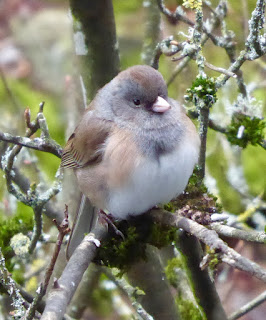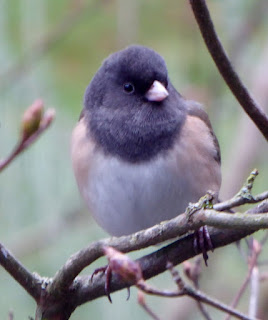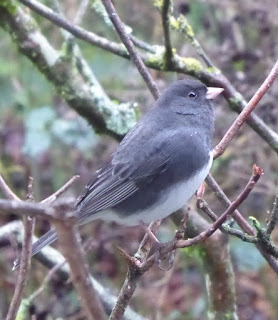 |
| Oregon Junco female |
Shitty birder Murr reporting in again, with birdy enthusiasm and Magic Slate brain. Birds are erased from my memory as fast as they slide in. It’s a problem, if you want to have a Life List of birds that means anything.
I don’t. Instead, I will get all excited about spotting a Life Bird and one of my friends will say, “No, you saw that one back in 2012, perched at three o’clock in a western cedar, just to the right of a varied thrush.” And I will respond, “Who are you, again?”
So I was excited to find an honest-to-goodness new bird when I visited my sister in Colorado. I do know some birds pretty well, and this one acted a lot like a junco. For instance, it hopped around on the ground, both to and (as noted on the Audubon site) fro. And it had those white junco tail feathers. But this one was sort of bluish and had a red sweater, not at all like our Oregon Junco, which is brown and white with an executioner’s hood. I looked it up later and was pretty chuffed to discover it was indeed in the junco family. I had not only bagged a Life Bird but I’d gotten it down to a near relative.
 |
| Oregon Junco male |
Only, no. Hold on there, little missy! As it happens, there are at least five distinct juncos out there and all of them are now called Dark-Eyed Juncos. You see one, you’ve officially bagged them all. It’s totally not fair. If I’d seen them in 1972, I could have counted them as five different species, but since then, ornithologists, who are people unduly interested in bird sex, have decided they’re all the same thing.
This because in those areas where the different types overlap, they interbreed freely, as opposed to reluctantly.
(And the areas where they overlap would be your cloacal areas.)
Now, otters have been known to mate freely with cocker spaniels, but they are not considered the same species, because they do not get a live Cock-Otter out of it, and in fact the cocker spaniel usually doesn’t make it either. Otters are real cute, but they’re assholes.
But an Oregon Junco can mate with a Gray-headed Junco and get real operational nestlings out of the situation. I don’t know what they look like.
Juncos have been much studied because they’re easy to catch and relatively tolerant of manhandling, which is to say they don’t spazz out or drop dead. This is probably an unfortunate trait for the junco. Being studied by ornithologist rarely works out for the bird. Some early ornithologists messed with a bunch of juncos by exposing them to cold winter conditions while simultaneously adjusting their light exposure artificially to make it seem like spring, all to see if they went ahead and mated or just pooped in their water dish. I don’t know what they found out, but I’m sure it was grad students who had to clean it up.
 |
| Slate-colored Junco |
The reason all the forms are now considered the same damn bird is they have only begun to diverge recently, since the retreat of the glaciers around 13,000 years ago. That gave them plenty of opportunity to branch out sartorially while maintaining a healthy ecumenical horniness.
I’m interested in this because I happen to have a Slate-Colored Junco in my yard. Yes I do: he’s supposed to be east of the Great Plains, but he isn’t, he’s right here. Not only that, but he’s been coming here for at least two years. Yes, I’m going out on a limb and saying it’s the same individual, which means they spend a season up in Canada somewhere and then come right back to the very same city lot every time. Mine. And if my Slatey mates with an Oregon Junco and produces something new, say, something in a dapper plaid, I’m calling it Murr’s Junco. Junco murrus nanner-nanneri. Boo-yah.
Slate-colored juncos are the only ones we have here in Delaware, and I was surprised to see your Oregon juncos with that tasteful touch of buff on their sides. Juncos are such well-dressed birds; they look just as stylish whether at an informal brunch consuming the driveway cracked corn, or at a formal perch-down dinner at the feeder.
I've seen typically western birds here once in a rare while. What I find disturbing is the vulture dispersal: I now see only black vultures here (a southern bird) and no turkey vultures at all. I guess the turks went further north? I also see fewer mockingbirds (which would normally be year-round residents), but we get more catbirds in the summer (again, a southern bird.)
I'm not always sure what belongs here, especially since I occasionally find birds that don't even exist.
We have 8 DEJU in our garden now. They come every winter. I often wonder if the same ones return during winter. They are singing up a storm now. They will soon go back North. Congrats on seeing a different one. You might be pleasantly surprised if the powers that be in the birding world suddenly decide to split them.
Although–I'd still have only three juncos!
My "Life List", going back to the early 1950s, is but a suggestion of what I may have seen or what someone may have told me I saw at some point in my life. (Excitedly, I told my brother & his wife of my "lifer" Say's phoebe seen in CA, only to have my s-i-l point out the window at the Say's on my back yard wall in Albuquerque, "Like that one?" which, of course, I had never noticed.
Here in KS, if it has white stripes down the tail and flies up from under our winter feeders, it's a dark-eyed junco, regardless of the fact that my brother calls some of them "Oregons".
Still don't have a working life list, but at least my "Life" goes back to the early 1950s!
Congrats. I know how exciting it is. I saw my first close-up kinglet this year and bragged to everyone. I have fewer friends now, but it was exciting.
Ha ha ha ha ha ha ha ha
Incidentally, I can peg a kinglet in a half second now. I did it just the other day. I'm very proud of my kingletification.
We have a batch of dapper slate colored juncos under the suet feeders for the last couple of months. I have only ever counted five, and worry that one of them isn't getting any bird tail, unless the others are very open-minded.
Maybe that's what I'll call my particular junco variants: junco swingerri.
Our regulars AT the feeders are a pair of downy woodpeckers that I have named Robert and Roberta, and a pair of red-bellied woodpeckers that my daughter has named Mr. and Mrs. Asshole, as they tend to chase away all the other birds. In addition to an assortment of titmice, white-breasted nuthatches, and black-capped chickadees. Just saw my first-robin-of-spring a couple days ago, too.
My Downies are named Robert and Roma. We also have Hairy Woodpeckers, which look just like Downies, but on steroids. We have suet feeders hanging off our eaves, so we get to see them up close every winter.
We've had robins all year long. I've heard that they don't migrate; they just go deeper into the woods. Whether it's a scarcity of woods or the increase in temperature, they were here all "winter". I tend to think it is the latter (see black vulture and catbird comment.)
We have a lot of contenders here for the greater Asshole familly.
And just yesterday, we saw our first Hairy Woodpecker! I can't help but think that it was named by a 9-year-old boy.
God, I just love you.
!!!!
According to the rules of taxonomy, you can't name a species after yourself! But you could name it for a good friend of yours.
As far as the whole "if they can breed successfully (ie produce fertile offspring) with other birds, they must all be the same species" claim goes, it has been discovered recently (last twenty years or so) that a number of birds that were considered to be distinct species can and do breed successfully with other birds that belong to other distinct species. And in a lot of those cases, they remain labeled as distinct species because of various arcane reasons. Genetics is thinning out the species names to some extent, but in other cases is just muddying the water.
I'm sorry, I blacked out there just after the "you can't name a species after yourself." WTH.
Okay, you can do this Murr. First, Google your own name. Chances are, there is someone else who has your name. For instance, my name is shared by a "leading scholar and translator of Kant's philosophy." Just name your bird after this person — or say that it's after her.
Apparently, Kant's philosophy was about morality… which, as should be obvious from this comment, I have have absolute;y no acquaintance with.
If I were being entirely honest, I'd have to suggest that the odds I'd find a previously undiscovered bird are low.
As I can only just distinguish a crow from a chickadee, this was a bit like reading Greek!
P. S. I am not Greek
I was going to make you state that!
They're pretty little birds, about palm of the hand size?
Whose hand? Basic sparrow size, I'd say. Bigger than Studley.
Juncos seem to make the ground come alive when they come in for breakfast. Slate-colored are the only version I have seen around here. As the snow melts we are seeing some of the more colorful birds migrate back.
I like spring as much as (but not more than) the next guy–I love winter!–but the coming-backness of birds is a bigger and bigger deal for me every year.
you boomers are shutting down the entire economy because you're afraid of a flu. Seriously, can you boomers kill yourselves? You are the most selfish generation to ever exist. You don't give a shit about climate change, why should we young people give a shit if you get sick and die of some virus? I HOPE the virus gets much stronger and kills you all.
Do you boomers realize how universally hated you are? There is not one single demographic that does not hate you- white people, black people, asians, mexicans, indians, chinese, millennials, GenX, GenZ. Something tells me that you boomers are not going to have a very comfortable or easy retirement, especially once you end up in the retirement homes.
Can you baby boomers hurry up and fucking drop dead? Enjoy your retirement homes cause we younger people will not take care of you even if we wanted to, due to the shitty economy you boomers created. Do you boomers realize that the younger generation is simply waiting for you to fucking drop dead?
You are all going to end up in retirement homes and we all know that the elderly gets treated pretty badly in retirement homes. Well, that's what you get for ruining your own children's lives. Even if your children WANTED to take care of you, they couldn't, due to you boomers destroying the economy. So I hope you enjoy the retirement homes, boomer scum!
Bless your heart. Aren't you tired of doing this same cut and paste job twice weekly now for how long? It seems forever.
Besides, Mom wants to know what you want for supper…and if you need your overalls pressed. Also, do you need a new batch of tiki torches, hon? She's going to the Dollar Store later to pick up a few necessaries for you. Be a good boy while she's gone.
Bless your heart.
*Virtual hug* You probably need one, right? I mean, happy people don't become trolls. I hope somebody loves you someday.
Oh yeah, you may not have a mental life list (I can't hold that much info in my head either), but do you have a written one? You're literary, you can do it! I found it to be really easy and didn't take long at all to assemble the structure.
Nope! I've started one once or twice but then I forget about it! I thought the YARD list should be doable…but I forget about that one too.
OMG, ohmemercylard, that was the most perfect reply to anything I've ever read. LOFL.
Haha, says my birding expert spouse, citing Sibleys p. 532: Yellow-eyed junco is still a holdout and will not indulge in sex with any variety of dark-eyed no matter how sexy those dark eyes are.
No haha! I said Dark-eyed junco. The yellow-eyed are different. Not as different as ALL THE DARK-EYED ONES…
Hello dear friend's I am Lucy Giroud, from Paris Saint, France. My Contact +33605803296
How are you and your lovely family.
I was diagnosis of , systemic lupus erythematosus. And Herpes Simplex 1 and 2 for 9 year, but now I am a living testifer of Dr Ogbeifun natural herbel medicine in which he use in curing me permanently…
I order two bottles of his herbal product to cure lupus. I take the herbal medication for 14 day's the way he instructed me to be drinking the herbs
Three tables spoon in the morning and evening after food.
Dear friend's God Almighty have be using this man Doctor Ogbeifun to help the sick once who is ready to help their selves. Because once you are ready. He will be also ready to help you with his herbal medicine.
Via… What'sApp: +2348050680253
Email address: drogbeifunherbalhome1@gmail.com
Website: https://doctorogbeifun.wixsite.com/drogbeifunherbalho-1
God bless you all?
Software is like sex: it’s better when it’s free. Hey, i am looking for an online sexual partner 😉 Click on my boobs if you are interested (. )( .)